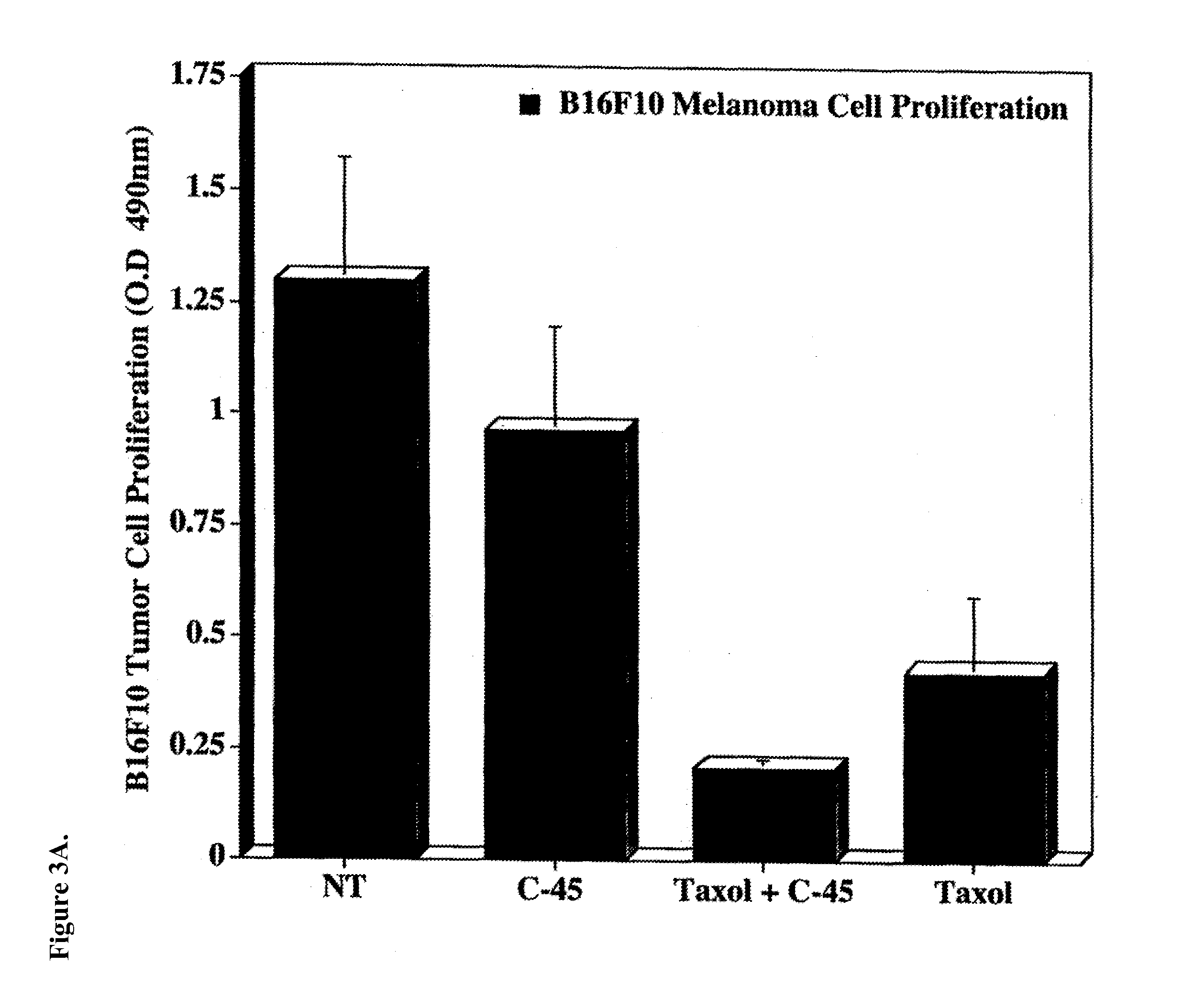Treatment of cancer using the sodium salt of a benzoic acid derivative
a technology of benzoic acid and cancer, applied in the field of cancer treatment, can solve the problems of tumor cell growth arrest and senescence, drug resistance, and cancer cell growth arres
- Summary
- Abstract
- Description
- Claims
- Application Information
AI Technical Summary
Benefits of technology
Problems solved by technology
Method used
Image
Examples
example 1
PABA and Derivatives Inhibit Tyrosinase Activity In Vitro
[0104]Methods
[0105]Activity of purified tyrosinase was measured by monitoring the formation of DOPAchrome. Briefly, a fixed concentration of L-DOPA (8.0 mM) was incubated with 800 U / ml tyrosinase (from mushrooms-Sigma, St. Louis, Mo.) in the absence or presence of increasing concentrations of PABA, compound 44 (C-44) and compound 45 (C-45) (see FIG. 1 for structures) for indicated time points (see FIG. 2 for concentrations and time points). At each time point, 100 μl of the reaction mixture was measured. Data points represent the mean optical density at 475 nm±SD from triplicate wells.
[0106]Results
[0107]As shown in FIG. 2, PABA, C-44, and C-45 all inhibited tyrosinase activity at 8.0 mM up to 10 minutes, the last time point measured. By contrast, untreated samples demonstrated linearly increasing tyrosinase activity up to 10 minutes. This approach can be applied to evaluate other benzoic acid derivatives or other compounds for...
example 2
Effects of PABA Derivative C-45 on Carcinoma Cells Treated with Chemotherapy
[0108]Methods
[0109]Tumor cell proliferation was assessed by monitoring mitochondrial dehydrogenase activity as detected by tetrazolium salt cleavage using a commercially available kit (WST-1; Roche, Indianapolis, Ind.). Briefly, B16F10 melanoma cells, Lewis Lung carcinoma cells, and 4T1 breast carcinoma cells (1×106) were resuspended in PABA-free growth medium supplemented with 2.0% fetal bovine serum and 50 μg / ml of test compound (as shown in FIG. 1) Following incubation for 3 days, the cells were either treated or not treated with 0.01 μM TAXOL® and incubated for an additional 48 hours. Proliferation was measured; data points represent the mean optical density at 490 nm±SD from triplicate wells.
[0110]In addition, tumor growth in vivo of xenografts of B16F10 melanoma cells in nude mice was determined Briefly, subconfluent cultures of B16F10 cells were harvested, washed, and resuspended in sterile PBS. Femal...
example 3
The Effect of C-45 on Radio- and Chemosensitivity In Vivo
[0114]Methods
[0115]The chick embryo tumor growth model was used to determine whether C-45 enhances the ability of TAXOL® or ionizing radiation to inhibit tumor growth. Briefly, B16F10 melanoma cells were cultured in growth medium in the presence or absence of 50 μg / ml C-45 for at least 7 days. Following harvesting and washing, about 2×105 tumor cells were implanted onto the chorioallontoic membranes of 10 day-old chick embryos and incubated for at least 24 hours. Following incubation, the embryos were treated with either a single fractionated dose of radiation (5.0 Gy) or TAXOL® (paclitaxel) (0.01 μM) and incubated for an additional 7 days. The embryos were sacrificed and tumors were resected and weighed (5-10 embryos per condition).
[0116]Results
[0117]FIG. 5A-B demonstrates the effect of C-45 on radiation- and chemotherapy-treated tumor growth in chick embryos. As shown in FIG. 5A, while treatment with radiation and C-45 alone...
PUM
| Property | Measurement | Unit |
|---|---|---|
| Composition | aaaaa | aaaaa |
Abstract
Description
Claims
Application Information
 Login to View More
Login to View More - R&D
- Intellectual Property
- Life Sciences
- Materials
- Tech Scout
- Unparalleled Data Quality
- Higher Quality Content
- 60% Fewer Hallucinations
Browse by: Latest US Patents, China's latest patents, Technical Efficacy Thesaurus, Application Domain, Technology Topic, Popular Technical Reports.
© 2025 PatSnap. All rights reserved.Legal|Privacy policy|Modern Slavery Act Transparency Statement|Sitemap|About US| Contact US: help@patsnap.com



